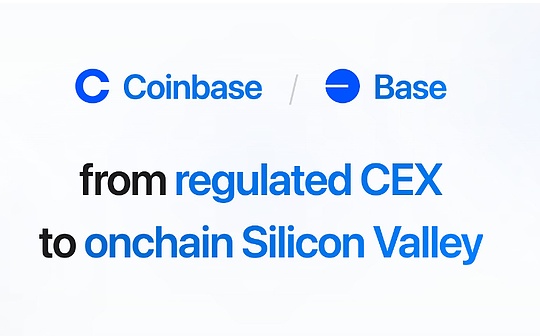
Author: Can Gurel, Delphidigital Compilation: BTCDAYU Source: X,@BTCDAYU
Point
-
Everyone executes the overall chain of each transaction is essentially irreplaceable.Therefore, the multi -chain world that appears in a certain form is inevitable.We believe that modular blockchain may be the best way to multicked the world.
-
Celestia is the first real modular blockchain.”Its vision is to combine COSMOS’s sovereign interoperability area with the Ethereum with a summary of the shared security.”
-
Celestia is expanded by decoupled the execution and consensus and introduced data availability sampling.This enables Celestia to imitate the characteristics of BitTorrent. BitTorrent is one of the most scalable and decentralized agreements so far.In the foreseeable future, Celestia is expected to effectively support any potential user needs, while maintaining a relatively stable verification cost.
-
Re -imagine the blockchain as a modular stack has the effect of exceeding scalability.Celestia’s unique advantages include trust minimum bridges, sovereign chains, high -efficiency resource pricing, simpler governance, easy chain deployment and flexible virtual machines.
-
Modular blockchain is a paradigm for blockchain design. We expect their network effects to become more and more obvious in the next few years.Especially Celestia’s main network is expected to be launched in 2023.
Introduction
Everyone executes the overall chain of each transaction is essentially irreplaceable.In fact, this is why almost every major ecosystem is building a multi -chain world.
As we explained in the previous article, ecosystems are different in how to imagine the multi -chain world.The two methods that attract the most activities today are Ethereum and COSMOS.
In short, Ethereum imagined a future centered on rollup.Rollup is often more expensive and flexible than L1, but they can share security with each other.
In contrast, COSMOS is an ecosystem composed of interoperable sovereign L1 (called “region”).Although the area is cheaper and more flexible than RollUps, they cannot share complete security with each other.
Celestia combines the advantages of these two worlds.As a wise man once said, “Celestia’s vision is to combine COSMOS’s sovereign interoperability area with shared security with Rollup -centered Ethereum.”
>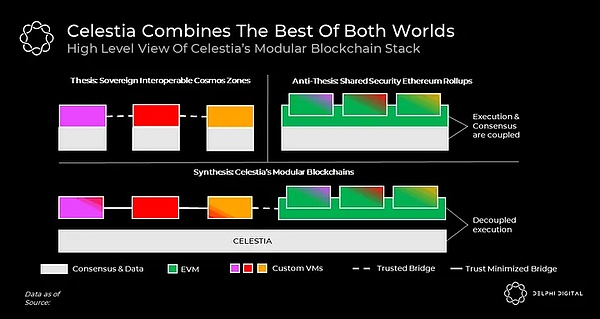
If you do not fully understand the chart above, don’t worry.When we deeply study the modular blockchain design of the Celestia paradigm transition, we will solve everything in this article.We will use the first half of the article to answer the “what” Celestia, and the second half to solve the “cause” of Celestia.If you are familiar with the working principle of Celestia, we recommend that you jump to the second half of this article, and we list its 8 unique attributes.You may be surprised to discover that Celastia means deeper and stronger than its surface.
Second, the working principle of Celestia —— Decodic Execution
To understand the “principle” of Celestia, we must first define its problem statement.The birth of Celestia is to find the answer to the following questions: “What can the blockchain do at least to provide sharing security for other blockchain (that is, summary Rollup)?”
Generally, consensus and effectiveness are the same thing.However, these concepts are likely to be independent.The validity rules determine which transactions are considered effective, and consensus allows nodes to reach the order of effective transactions.
Just like any L1 blockchain, Celestia implements a tendermint to sort the transaction.However, unlike the typical blockchain, CELESTIA does not reason the effectiveness of these transactions and is not responsible for executing them.Celestia treats all transactions equally; if the transaction pays the necessary fees, it will accept, order and copy it.
All transaction validity rules are enforced by the summary node on the client.Rollup nodes monitor Celestia to identify and download their transactions.They then execute them to calculate their status (such as determining each person’s account balance).If any transaction is considered invalid, they will ignore them.
>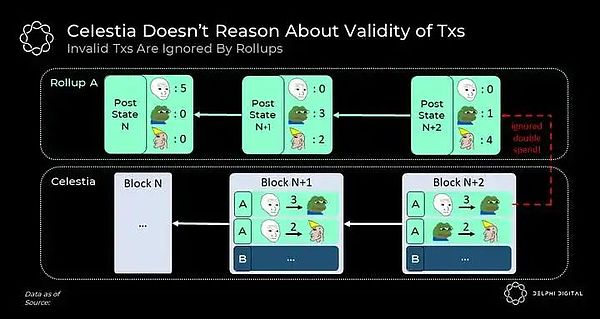
As you can see, as long as the history of Celestia remains unchanged, a summary node running with the same effective rules can calculate the same state.
This has brought us important results.Rollup does not require another chain to perform any execution to share security.On the contrary, what they need is only reaching an agreement on the sharing history of orderly transactions.How does Celestia expand?
Although the execution and consensus decoupling lays the foundation for Celestia’s unique capabilities, the scalability level implemented by Celestia cannot be explained by decoupling.
The obvious advantage of decoupling execution is that nodes can freely execute transactions related to applications that are interested in, rather than performing all transactions in the default.For example, nodes of gaming applications (summary of applications) do not have to be interested in transaction executing DEFI applications.
In other words, the scalability advantage of decoupled execution is still limited because they are at the cost of combined.
Let us imagine the situation where the two applications want to exchange some token.In this case, the state of each application will depend on each other; to calculate the state of an application, nodes must execute transactions related to these two applications.
In fact, as each new application adds these interactions, the number of transactions to be executed must increase.In extreme cases, if all applications want to interact with each other, we will return to all aspects of a single chain, and everyone downloads and executes each transaction.
So how does Celestia realize unparalleled scalability and what does it have to do with the decouple of implementation with consensus?
Third, scalability bottleneck
Scalability is usually described to increase the number of transactions without increasing the cost of the verification chain.In order to understand where the scalability bottleneck is, we briefly review how the blockchain is verified.
In a typical blockchain, the consensus node (verification, miner, etc.) generate blocks, and then distribute them to the rest of the network consisting of a complete node and light node.
The whole node has high available resources, and fully verify the contents of the receiving blocks by downloading and executing all transactions.In contrast, due to limited resources, light nodes (99 % of users) cannot verify the contents of these blocks, and can only track the block head (Abstract of the block data).Therefore, the security of light nodes is much lower than the full node; they always think that consensus is honest.
Please note that the full node will not make this assumption.Contrary to the popular views, the malicious consensus can never deceive the entire node to accept invalid blocks, because they will notice invalid transactions (such as double flowers’ transactions or invalid coins) and stop paying attention to the chain.
The most infamous scalability bottleneck in the blockchain field is called state expansion.With more transactions, the state of the blockchain (the information required for the execution of the transaction) will increase, and the cost of running a complete node will become higher.This will lead to the situation that does not want to occur, that is, the number of all nodes has begun to decrease, and the number of light nodes begins to increase, so that the network is concentrated around the consensus node.
Since most chains attach importance to decentralization, they hope that their complete nodes will run on consumer hardware.This is why they limit their state growth by enforcement of block/gas size restrictions.
Crack and validity proof
The invention of fraud/validity proof effectively eliminated this bottleneck.These are simple proofs that can be effectively executed by light nodes to verify whether the content of the verification block is valid without the need to perform transactions in it.The advantage of the solution is that any single node with a complete chain state can generate these proofs.This is very powerful, because this means that light nodes can be run under the same security guarantee as the whole node, and the amount of resources consumed at the same time should be a few orders of magnitude.
Here are a simplified example of anti -deception.In anti -fraud, the whole node provides sufficient data for light nodes to allow them to identify invalid transactions independently.The first step of this proof requires a full node to the light node to indicate a specific data (such as TX claiming invalid) belongs to the block.
This is quite simple because Merkel Tree can be used to do this.By using the Merkel tree, the whole node can effectively prove to the light node to prove that the specific transaction is included in the block without the need to download the entire block.
However, although it is proven to contain the transaction is simple, it is not the case that there is no transaction.This is a problem, because as we will see in the next section, it is also important that there is no transaction or a transaction that contains transactions to fraud/effective proof.
Data usability problem
In order to allow the whole node to generate fraud/effective proof, they must be able to calculate the status -account balance, contract code, etc.
This requires a complete node to download and execute the “all” transactions.However, if the malicious consensus releases the blockhead but retains some transactions in the block?
>
In this attack scenario, the whole node is easy to notice the loss of data in the subject, and rejects the chain.However, only the light nodes of downloading the header will continue to follow it because they will not notice any differences.
Data usability is a prerequisite for fraud and validity proof
Please note that this problem applies to solutions based on fraud and validity proof, because the honest complete node cannot generate fraud/valid proof without access to complete data.If data detain attack occurs
In the anti -fraud system, light nodes will track the head of the potential invalid chain.Therefore, honest nodes can no longer verify the block.
In a system based on validity proof, light nodes will track the header of a chain with an effective but unknown state.Therefore, honest nodes can no longer generate blocks.This means that without the consent of the attacker, the chain will not be able to continue.This is similar to the attacker to keep everyone’s funds.
In any case, the light nodes will not notice the problem, and you will accidentally split out of the complete node.
The problem of data availability is essentially a very delicate problem, because the only way to prove that there is no transaction is to download all transactions, and this is what the light node wants to avoid doing due to resource restrictions.
Celestia solves the problem of data availability
Now we have determined the problem, let’s see how Celestia solves it.Earlier, when we distinguished effectiveness and consensus, we mentioned that Celestia did not care about the effectiveness of the transaction.However, Celestia really cares about whether the block producer has fully released the data behind the head.
Celestia has extremely high scalability because the usability rules can be independently performed by light nodes with limited resources.This is completed by a novel process called data availability sampling.
Data usability sampling (DAS)
DAS depends on a long -term data protection technology, called the deletion code.Although Celestia realizes the scope of this report, it is very important to understand its basic principles.
Applying the corner code to a section of data can expand it in a way that can restore the original data from a fixed part of the extended data.For example, a piece of data can be erased to double the size, and it can be fully restored from the extension data of*50% of the*50%.By rectifying the block in a specific way, CELESTIA enables light nodes with limited resources to be randomly sampled from the block for some fixed small -sized data blocks, and have high probability to ensure that all other blocks are available for network use.This probability guarantees the number of nodes participating in the sampling process.
Care DAS as a game, the malicious block producers try to hide the data in the block without being noticed by the light node.Block producers release the header.According to the data root submitted in the header, each light node starts to request random blocks from the block (and the corresponding Merkle proof contained in the data containing the data).
>
There are two results in the game:
1. Data can be available -& gt; malicious block producers release the block from the block according to the light node request.The release block is spread through the network.Although each sampling light node is only a small amount of samples, considering that their common sampling block exceeds 25%of the tactical block, any honest all node in the network will be able to restore the original block from the broadcast block.As the complete block is now available for network use, all light nodes will eventually see their sampling tests successfully, and they are convinced that the complete data behind the header is indeed available for full nodes.
Through autonomous verification data is available, light nodes can now rely entirely on fraud/effective proof, because they know that any single honest complete node can generate these proofs for them.
2. Data is detained -& gt; malicious block producers do not release the request block.Light nodes noticed that their sampling test failed.
Please note that this is no longer a serious threat to security, because the malicious consensus can no longer deceive the light node to accept the chain rejected by the full node.Therefore, the block of the loss of data will be displayed as the active failure of complete and data sampling light nodes.In this case, you can securely restore the chain through the ultimate security mechanism of all blockchain -social consensus.
All in all, in any case, the complete data sampling light node will eventually follow the same chain, so it will run under almost the same security guarantee.
How much can Celestia provide?
One key feature of DAS is that the more collective data sampling, the same as possible to provide the same probability availability guarantee for the larger data amount.In the context of Celestia, this means that it can securely increase the block through more nodes to participate in the sampling process (that is, support higher TPS).
However, DAS has inherent weighing.Due to technical reasons (we do not discuss here), the block head of the data sampling nodes is increased proportional to the square roots of the size of the block.Therefore, it is hoped that light nodes with almost the same security as the whole node will go through the cost of O (√N) bandwidth, of which n is the size of the block.
In terms of scalability, there are two leading factors play a role;
-
How much data can be concentrated
-
The target of the light node
Any of these one will cause restrictions on Celestia’s DA throughput.
Below we share the current estimate of the CELESTIA team research, considering the first influencing factor.
>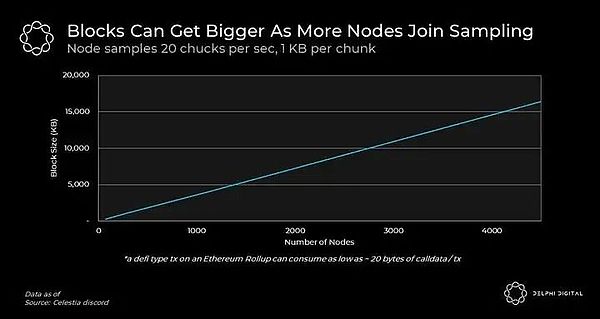
It is important that the size can be much larger than the display here, because DAS can be executed by a large number of audiences with limited resources.Even smartphones can participate in the sampling process and contribute to Celestia’s security and throughput.In fact, this is an example of a smartphone contributed to Celestia’s security!
In fact, the number of sampling nodes is quite related to user demand.This is very exciting because it defines CELESTIA’s block space supply as a function that requires.This means that unlike the single chain, Celestia can provide lower stable costs with the growth of user needs.
Now let us enlarge the second factor; the size of the light node block head is proportional to SQRT with the size of the block.Although this may seem to be a restricted factor, over time, increasing resource demand may be offset by the improvement of network bandwidth.
Please note that DAS has a double effect on bandwidth improvement.If the bandwidth capacity of the average light node increases X, Celestia’s DA throughput can safely increase X²!
Finally, unlike Moore computing laws that are expected to end at some point in the 1920s, the Nelson Internet Bandwidth Law may seem to continue to apply in the next decades.Therefore, by making the calculation completely out of the chain, Celestia can make full use of the index of network bandwidth to grow.
Considering all factors, Celestia is expected to actually support any potential user needs in the foreseeable future, while maintaining the verification costs quite stable.By abandoning execution and introducing DAS, Celestia can imitate the scalability characteristics of the most scalability decentralized protocols known on the Internet.
Fourth, the characteristics of modular CELESTIA Stack
Now we have introduced the working principle of Celestia, let’s take a look at the benefits of modular blockchain.The significance of re -imagining blockchain as a modular stack has exceeded the pure DA scalability.Below we introduce the 8 unique design attributes of the modular Celestia stack, which may not be obvious immediately.
Sovereignty
Today Rollups runs as Ethereum’s baby chain.This is because they posted the header on Ethereum, and their fraud/effective proof proved to be executed on the chain.Therefore, their standards are determined by a series of smart contracts on Ethereum.
It is important to recognize this, because this means that the summary must have a chain governance mechanism by default.However, there are risks such as low participation, ticketing, and centralization of voters on the chain governance.Due to these complexity, the governance on the chain has not been used as the preferred governance method by most blockchain.
Rollups on Celestia is very different.As we saw before, Celestia did not make any significance for the data it stored, and left all the explanations to the summary node.Therefore, the specified status on Celestia is independently determined by nodes that choose to run specific client software.In fact, this is the general way of operating in today’s L1 blockchain.
Therefore, Rollup on Celestia is essentially self -sovereign blockchain.By upgrading the software and selecting the underlying data in different ways, nodes can be freely performed by hard/soft forks.For example, if the community is arguing about the changes in the size of the block or the tokens, the opposition can update their software to follow different effective rules.When we think about its deeper meaning, you will notice that this function is more exciting than it looks.
In the field of first -level blockchain, controversial hard split forks are usually considered to be high, because the fork chain will eventually weaken its security.Therefore, people often avoid forks at all costs to suppress experiments.
In the history of the blockchain, Celestia first brought a fork ability to the blockchain for the first time without worrying about safety dilution.This is because all splits will eventually use the same DA layer instead of abandoning the security advantages of the Celestia consensus layer.Imagine how smooth the blockchain operates from the beginning, how smooth the problem of the Bitcoin block or the Ethereum DAO fork can be solved.
We expect this to accelerate the experiment and innovation in the blockchain field to reach the level that can be imagined by today’s infrastructure.The visualization below comes from the Perfect Explanation thread.
>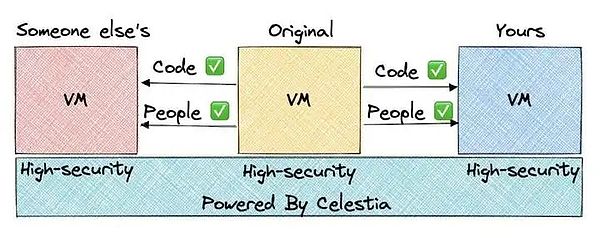
flexibility
Another force that will specialize in the pace of innovation in the field of virtual machines is the nature of Celestia that has nothing to do with execution.
Unlike Ethereum Rollups, Rollups on Celestia do not have to design scam/validity proof for EVM explained.This opens the VM design space on CELESTIA for the larger developer community and makes it face fierce competition.
Today, with the emergence of Starkware, LLVM, Movevm, COSMWASM, Fuelvm and other products, we have witnessed the appearance of alternative virtual machines and received attention.Customized virtual machines can innovate in all aspects of execution; support operations, database structures, transaction formats, software language, etc. to solve the best performance while solving specific cases.
Although Celestia itself does not expand its execution directly, we expect it to laid the foundation for the VM market that has nothing to do with execution that has nothing to do with high -function and scalability.
Make an easy deployment
If there is a trend in the field of cryptocurrencies that have not changed for many years, it is how easy the blockchain deployment is.
>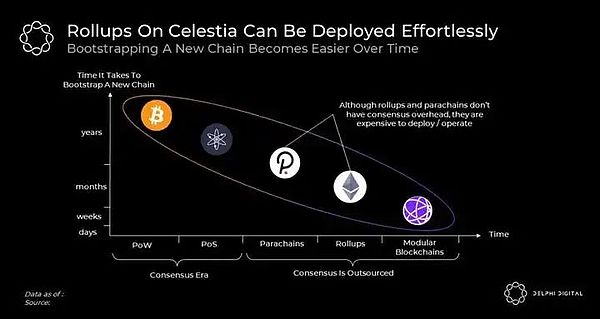
In the early days, if there was no POW hardware, the decentralized network could not be started; this bottleneck was eliminated through the introduction of POS.Like POS, mature developer tools such as COSMOS SDK make it easier to release a new blockchain.However, despite the progress, the expenses that guide POS consensus are far from ideal.Developers must find a new authentication set to ensure that they have a wide range of tokens and the complexity of consensus.
Although the Polkadot parallel chain and Ethereum Rollup eliminate this bottleneck, the deployment cost of the former is still high, and the latter’s operating costs are still high.
Celestia seems to be the next evolution of this trend.The Celestia team is using COSMOS SDK, which is called Optimint for the Oru specification.The tool solves future needs with other tools, that is, any chain can be deployed, and developers do not have to worry about consensus overhead or expensive deployment/operating costs.The new chain can be deployed within a few seconds and allows users to interact safely from the first day.
High -efficiency resource pricing
Ethereum plans to launch its shard plan in stages in the next few years.Based on this, it will have pure data shards, and the summary can only be used to publish data.With the increase of basic data capacity, this will naturally lead to cheaper summary costs.However, this does not mean that Ethereum abandons its state of execution environment on its L1.
Ethereum has a sacred execution.To run a complete verification node on Ethereum, you must also be interested in the L1 state of Ethereum.However, Ethereum already has a huge state, and performing in this state is by no means a cheap task.This huge country has applied for growing technical debt to summarize.
To make matters worse, the same unit (that is, L1 GAS), which limits the size of the L1 state, is also used to measure the historical data of the measurement summary.Therefore, whenever the activity on L1 surge, all summary expenses will rise accordingly.
>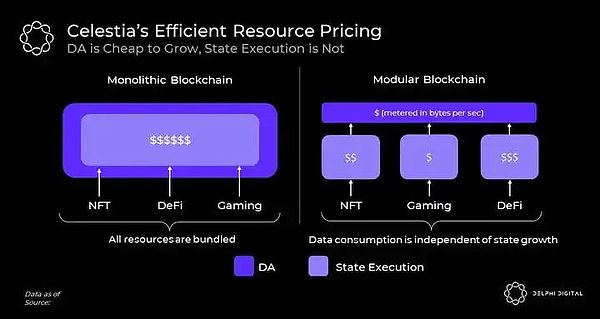
In the modular blockchain stack of Celestia, the active growth and historical data are completely processed separately according to the due way.Celestia’s block space only stores historical summary data based on bytes to measure and pay, and all states are measured by summarization in their own independent units.Because the activity is affected by the different expense markets, the surge in activity in one execution environment will not damage the user experience in another execution environment.
Trust the minimum bridge
One way to understand the entire L1 and L2 controversy is to see them as some chains and bridges.
In general, there are two forms of bridges: trust and trust to minimize.The trusted bridge depends on the consensus of trading the opponent’s bracelet, and the trusted minimum bridge can be guaranteed by any single complete node.
In order to make the blockchain form a bridge that minimize trust, they need two things: (i) the same DA guarantee (ii) explaining the way of mutual fraud/effective proof.
Because L1 does not meet the previous conditions of sharing DA, they cannot form a bridge that minimize trust.The best thing they can do is to communicate with each other’s consensus, which inevitably means a reduction in security.
On the other hand, Rollups communicates with Ethereum in a trusted way.Ethereum can access the data of Rollup and perform its fraud/effective proof on the chain.This is why Rollup can have a trusted bridge with Ethereum, and can be protected by any single Rollup node.
The chain with a trusted minimum bridge can be regarded as a cluster.Celestia lays the foundation for forming a cluster between chains.However, this does not force them to do so.The chain above Celestia can be free and independent, and it can also minimize the trusted and trusted bridge in the vast bridge design space.
>
Contrary to the general view, fraud and effective proof can take effect without execution on the chain.They can also be distributed in the P2P layer (as shown in the cosmos cluster above) and execute on the client.
The minimum governance
Blockchain governance progresses slowly.Improvement suggestions usually take years of social coordination to implement.Although this is due to security considerations, it greatly slows down the pace of active development in the blockchain field.
The modular blockchain provides a superior way for blockchain governance. The execution layer can act independently and quickly and break things, while the consensus layer can maintain elasticity and stability.
If you look at the history of EIP, you will find that a large part of the proposal is related to execution functions and performance.They usually involve operational pricing, adding new operating codes, and defining token standards.
In the modular blockchain stack, these discussions will only involve participants who involve the corresponding execution layer, and will not penetrate the consensus layer.In turn, it means that the problems that need to be solved at the bottom of the stack will be much less, and because the threshold for social coordination is high, progress must be slow.
Decentralization block verification, not production
Decentralization has different meanings for different teams.
Many projects attach importance to high -decentralized block production, and imitate POW’s ability to decentralize block production in POS settings.AlgAnt’s random leader elections, Avalanche’s second sampling voting, and Ethereum consensus shards are all famous examples in this regard.These design choices assume that the resources of block producers are low to achieve high -decentralized block production.
Although these are valuable technology, it is difficult to say whether they can actually bring more meaningful decentralization than other technologies.
This is because factors such as the overall scale of the agreement, the resource pool and the cross -chain MEV are important catalysts, and the block production has a centralized trend.According to experience, although there is technology, equity/hash eventually follow the distribution of Pareto.
In addition to these, there is another more important point about this theme.The most important factor in decentralization is block verification rather than production.
As long as the behavior of a small group of consensus nodes can be reviewed by a large number of participants, the blockchain will continue to run as our favorite machine.
This is the core argument of Vitalik’s recent endurance articles. Vitalik said, “So what is the result? Block production is centralized, block verification is trusted and highly decentralized, and the review system is still stopped.”
Similarly, although CELESTIA has higher requirements for block producers, it has low demand for verifications, thereby achieving a highly decentralized and anti -review network.
Simple
Clearly identifying the scalability bottleneck of the blockchain helps the Celestia team to make the simplest design choices.
Although Ethereum achieved DAS at the end of its shard diagram, Celestia preferentially considers it and clearly chooses not to follow the complicated consensus shard route.
Similarly, Celestia does not implement a new fancy consensus agreement. Instead, it chooses to use the ordinary old Tendermint, with mature tools and extensive developers/verifications.
We believe that over time, these design options will make Celestia stand out, and when Celestia will be more appreciated when RollUp is increasingly seeking cheap data availability solutions to enter the market.
5. Future challenges/restrictions
Celestia is creating a brand new blockchain design.Although we believe this is a model better than the existing solution, there are still some challenges that have not been explored.
The first challenge we foresee is related to the appropriate size.As we discussed in this article, Celestia’s block size can be safely increased with the number of data sampling nodes in the network.However, data sampling is not a process of anti -witch attack.Therefore, there is no verification method to determine the number of nodes in the network.In addition, because the nodes involved in the sampling cannot be rewarded by the protocol, the assumptions of sampling must be dependent on hidden incentives.The process of determining and updating the size of the target block will be subject to social consensus, which is a new challenge for consensus governance.
Another challenge in the future is related to Celestia’s guidance network effect.Obviously, there is no great effect on the dedicated DA layer without execution.Therefore, unlike other blockchain, Celestia will rely on other execution chains to start user activities.To this end, one of the initial cases of Celestia will be the DA solution under the chain of Validiums (ie Celestiums) on Ethereum.Celestium is the easiest goal in the launching activity of Celestia block space.
Another project is CEVMOS; the COSMOS SDK chain with built -in EVM is specifically used for summary settlement.Rollup on CEVMOS will publish their data to CEVMOS, and then Cevmos will publish it to Celestia.Just like today’s Ethereum, CEVMOS will execute a summary as a settlement layer.CEVMOS’s goal is to allow Ethereum Rollups to start locally on Celestia without changing its code library.
>
Finally, we foresee that restrictions related to the utility of the native currency of Celestia.Just like any other chain, Celestia will have a cost market, and its native token will accumulate value from the demand for Celestia block space.However, because Celestia does not execute status execution (except for the very small state execution of POS -related activities), unlike most chains, its tokens will be limited as the effectiveness of the liquidity sources of DEFI and other vertical fields.For example, unlike Ethereum that can be freely moved between Rollups and Ethereum by trust, Celestia’s native token must rely on the trusted bridge to be transplanted to other chains.
Six, conclusions
We believe that the modular blockchain is a paradigm for blockchain design, and it is expected that its network effect will become more and more obvious in the next few years.Especially Celestia’s main network is expected to be launched in 2023.
By decomposing the execution and consensus, Celestia not only realized the expansion and decentralization of the BitTorrent type, but also provides unique advantages, including trust minimum bridges, sovereignty chains, high -efficiency resource pricing, simpler governance, relaxed governance, relaxedChain deployment and flexible virtual machine.
As the first dedicated DA layer, Celestia does less.You can achieve more results by doing less.






